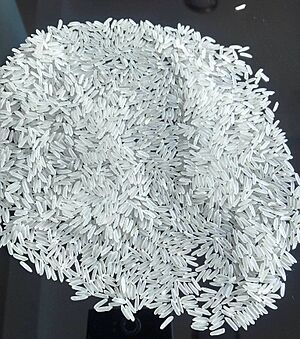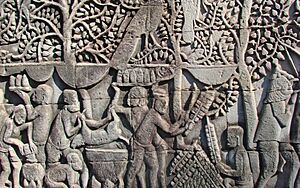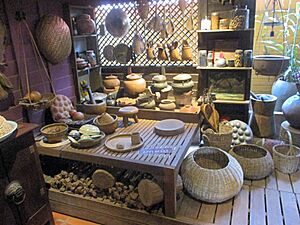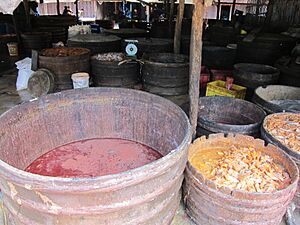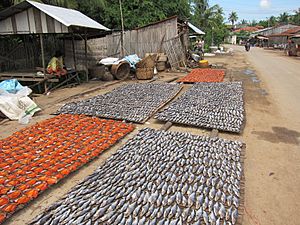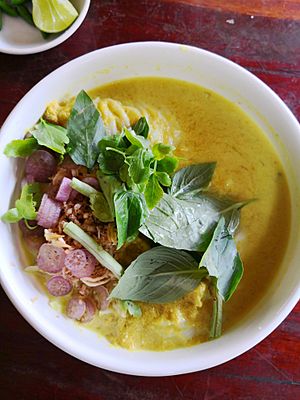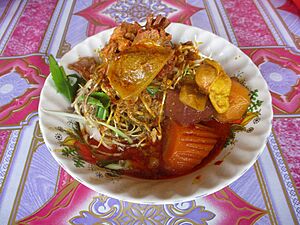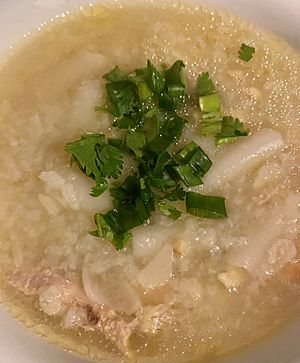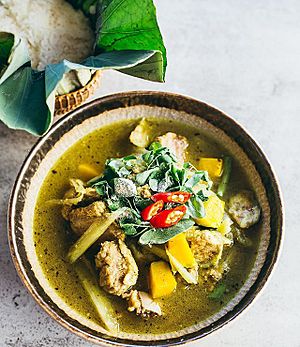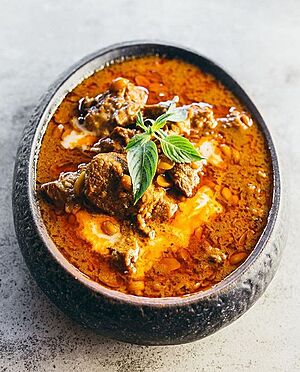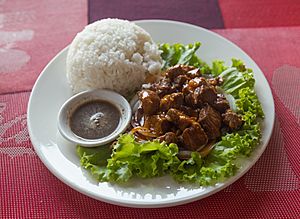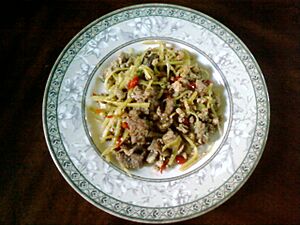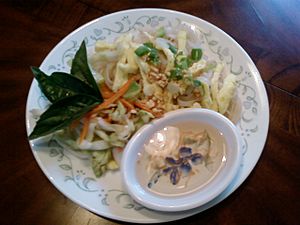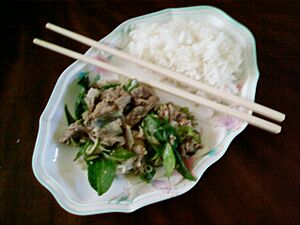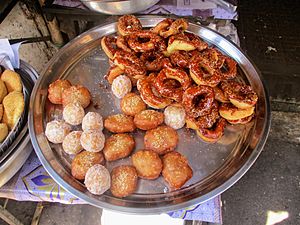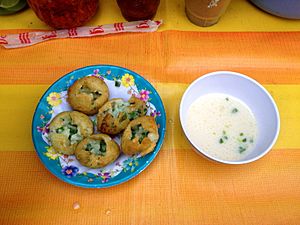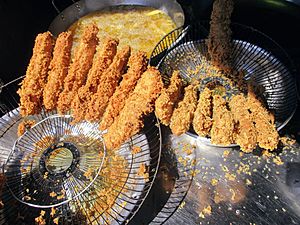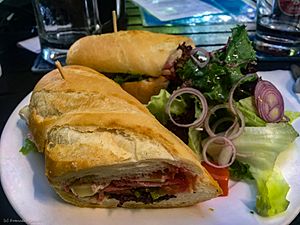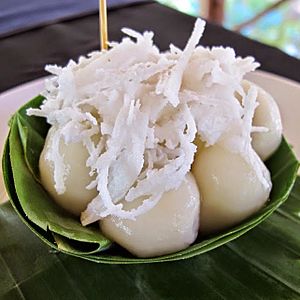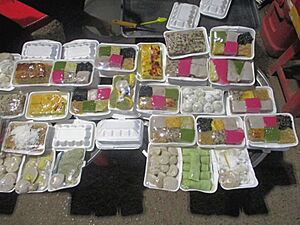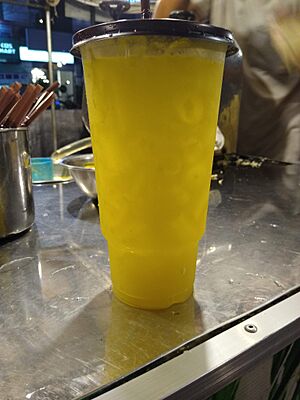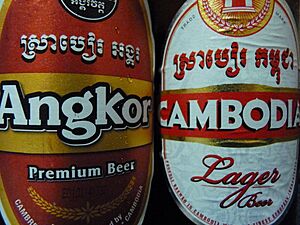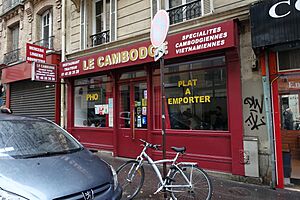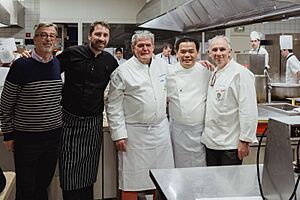Cambodian cuisine facts for kids
Cambodian cuisine is the name for all the different foods eaten by the many groups of people in Cambodia. Khmer cuisine (Khmer: សិល្បៈធ្វើម្ហូបខ្មែរ; meaning "Khmer cooking art") is specifically about the food of the Khmer people. Over time, Cambodian food has been influenced by Indian, Chinese, and more recently French cuisine. Because of these shared influences, it is similar to the food in nearby Thailand, Vietnam, and Laos.
Khmer cuisine can be divided into food for farmers, rich people, and royalty. However, the difference between royal and everyday food is not as big as in Thailand and Laos. Royal and rich people's dishes use more special and expensive ingredients, often with more meat. Farmer's food uses simpler ingredients that are easy to find.
Contents
- A Look Back: History of Cambodian Food
- How Cambodian Food Compares to Other Southeast Asian Cuisines
- Key Ingredients in Cambodian Cooking
- Popular Cambodian Dishes
- Drinks in Cambodia
- Meals and Eating Customs
- Cambodian Food Around the World
- Food Diplomacy: Sharing Cambodian Cuisine
- Awards for Cambodian Cuisine
- See also
A Look Back: History of Cambodian Food
Because of where Cambodia is located, rice and fish (especially freshwater fish) are super important for Cambodian meals. Rice is a main food eaten at almost every meal. People believe rice has been grown in Cambodia since 5,000 to 2,000 BC. During the Khmer Empire, people built amazing water systems that helped them grow rice and other crops three or four times a year!
The International Rice Research Institute says there are about 2,000 types of rice that originally came from Cambodia. Farmers there have grown these types for hundreds of years. One of them, "Malys Angkor" (ម្លិះអង្គរ, Mlih Ángkô), is even thought to be the best rice in the world.
Many spices in Khmer cooking came from Indian traders around the 2nd century. Indian influences on Khmer culture, including food, were noticed by a Chinese visitor around 400 AD. You can still see this Indian influence in coconut-based curries (Khmer: ការី, kari) and in boiled red and white sweets. Chinese people started arriving in the Khmer Empire in the 13th century. They brought their food, which led Cambodian cuisine to use many noodles and stir-frying techniques.
From the 9th to the 15th century, the Khmer Empire grew, and its cooking style spread to what is now Thailand, Laos, Vietnam, and Indonesia. The fancy food from the Khmer palace became a very special royal cuisine. When Khmer royal cooks were brought to the Ayutthaya Kingdom (in Thailand), they greatly influenced Thai royal food. Later, these recipes were changed in Thailand, adding some Portuguese influences. Then, they were brought back to Cambodia when Siamese armies attacked. Some even say Cambodian cuisine is "the original Thai cuisine."
In the 17th century, Portuguese and Spanish traders brought new foods from the Americas, like tomatoes, papaya, pineapple, corn, potatoes, sweet potatoes, cassava, and chili peppers. These were added to local dishes. The French later introduced foods like pâté, salads, wine, coffee, asparagus, and baguettes. After Vietnam took over parts of Cambodia in 1834 and during the time Vietnam controlled the People's Republic of Kampuchea (1979-1989), Khmer food was influenced by Vietnamese cooking. Dishes like beef lok lak became popular.
After World War II, many middle and upper-class families in Cambodian cities hired cooks who knew how to make French dishes. Because of this, children in these homes often didn't learn traditional Cambodian cooking. The sharing of traditional cooking knowledge was even more broken by the wars, hunger, and refugee problems in the 1970s and 1980s. When the Khmer Rouge took power in 1975, rice production in Cambodia had dropped a lot. Their strict rules, like banning private farming, foraging for food, owning food, and even private cooking, along with impossible rice goals and forced labor, led to a terrible famine. From 1975 to 1979, about 500,000 to 1.5 million Cambodians died.
Today, more and more Asian and Western fast food places are opening in Cambodia, especially in Phnom Penh. Fast food is becoming a bigger part of the food scene, especially for younger people. In 2004, Malis, the first fancy Cambodian restaurant, opened in Phnom Penh. Since the early 2010s, a new cooking movement called "New Cambodian Cuisine" has started in Siem Reap. Six Cambodian chefs are trying new things and modernizing traditional dishes. Also, mobile apps with Khmer recipes have been made, like "Khmer Cooking Recipe."
Cambodian Food in the United States

Since the late 1970s, about 200,000 Cambodians have moved to the United States. Many settled in Southern California, escaping the Khmer Rouge and the problems in Cambodia. Cambodian Americans own about 9,000 businesses, mostly restaurants and grocery stores that serve the Cambodian American community. Interestingly, Cambodian Americans own about 90% of the 5,000 independent doughnut shops in California. The most famous was Ted Ngoy, who owned about 70 doughnut shops and was called "The Donut King."
Over time, the food cooked by Cambodians in the United States became its own style. Meat, especially beef and chicken, is much more central to Cambodian American meals. They also use more tomatoes and corn. People who experienced severe hunger in the past tend to eat more fatty meats and have higher rates of obesity. Food made by second and third generation Cambodian Americans has become more "Americanized."
Cambodian cuisine is not very well known in the United States. Many Americans often compare it to Thai food. Most Cambodian restaurants are in cities with many Cambodian people, like Lowell, Massachusetts, Long Beach, California, and Seattle. Some Cambodian-owned restaurants serve other Asian foods like Thai or Chinese. Even in restaurants that serve Cambodian food, Chinese, Thai, and Vietnamese-influenced dishes are often more common than pure Khmer dishes.
Long Beach, California, has the most Cambodian restaurants in the U.S., with twenty-two. Some serve Thai food, while others serve Chinese food. Lowell, Massachusetts, has at least twenty Cambodian restaurants. The most famous Cambodian restaurant in the U.S. is The Elephant Walk, which serves French-inspired Khmer food. It opened in 1991 in Cambridge, Massachusetts. This restaurant also created "The Elephant Walk Cookbook," which is the first Cambodian American cookbook.
In 2000, a part of Central Long Beach was officially named Cambodia Town. Since 2005, an annual parade and culture festival takes place there, featuring Cambodian food. Since the late 2010s, a new group of second-generation Cambodian American chefs and restaurants in the U.S. are focusing on Cambodian cuisine. One example is the award-winning restaurant Nyum Bai, opened in Fruitvale, Oakland, California in 2018 by chef Nite Yun.
How Cambodian Food Compares to Other Southeast Asian Cuisines
Because of a lot of cooking connections and shared influences from India, China, and France, modern Cambodian food is very similar to the food in nearby Thailand, Vietnam, and Laos. Today, many Khmer dishes, like sour fish soups, stews, and coconut curries (including fish amok), taste very much like Central Thai food. However, Khmer dishes use much less chili and sugar, and more aromatic herbs and spices. Both Thai and Khmer royal kitchens use special herb pastes for curries, soups, and stews.
Khmer food has less in common with Northeast Thai and Lao cuisines. However, they all use a fish paste in their cooking. This paste is called prahok in Khmer, pla ra in Thai, and padaek in Lao. Many believe this fish paste came from the Khmer, as both Laos and Northeast Thailand were historically part of the Khmer Empire.
Cambodian food shares French influences with Vietnamese and Lao cuisine because Vietnam, Laos, and Cambodia were all part of French Indochina. Khmer dishes are generally less salty than Vietnamese food. They are also less sweet, more sour, and have more citrus flavors than South Vietnamese food. The ingredients and dishes of the Mekong Delta's native Khmer Krom people, especially spices (like cardamom, cinnamon, star anise, clove, ginger, turmeric, and ground coriander), curries, and fermented foods, have influenced the food of modern-day Southern Vietnam.
Key Ingredients in Cambodian Cooking
Fermented Sauces

In the Khmer language, different names are used for fermented seafood depending on how thick it is and what it's made from. Mam (Khmer: មាំ) is a general term for seafood fermented in a special way, often with solid pieces of the fermented ingredient. Prahok (ប្រហុក, prâhŏk) and kapi (កាពិ, kapĭ) are smoother than mam.
Mam is made by adding salt, roasted red sticky rice, and palm sugar to snakehead fish fillets. It then ferments for over a year. The palm sugar and rice give mam an earthy, sweeter taste and a reddish color. Prahok can be made from small fish with bones and less salt (called prahok chhoeung), or from large fish without bones and more salt (called prahok sach). Kapi is made by pounding clean, dried, and salted shrimp into a smooth paste. It is then sun-dried and pounded again until it becomes thick.
Prahok is used to flavor almost every Khmer dish. It can be mixed with rice or served as a dipping sauce (ទឹកជ្រលក់, tœ̆k chrôluŏk). It can also be made into its own dishes, like prahok k'tis (Khmer: ប្រហុកខ្ទិះ, prâhŏk khtih). Fermented fish roe (Khmer: ពងត្រី, pông trei) is mostly eaten with steamed eggs or omelettes. Kapi is often mixed with sugar, garlic, lime juice, chili, and crushed peanuts. It is used as a dipping sauce for vegetables, fruits, meat, and fish.
Other sauces in Cambodian cooking include fish sauce (ទឹកត្រី, tœ̆k trei), oyster sauce (ទឹកប្រេងខ្យង, tœ̆k préng khyâng), soy sauce (ទឹកស៊ីអ៊ីវ, tœ̆k si-iv), tamarind sauce (ទឹកអម្ពិល, tœ̆k âmpĭl), and hoisin sauce (ទឹកសៀង). Fish sauce is very important for adding saltiness to soups and noodle dishes, marinating meats, or as a dipping sauce. Oyster sauce, brought by Chinese immigrants, adds a sweet and tangy flavor to meats and stir-fried vegetables. Soy sauce is also common, often mixed with garlic or aged radish, and used for salty flavor when fish sauce isn't. Tamarind sauce is made from tamarind paste mixed with other flavors. Hoisin sauce is used to marinate grilled meat and for noodle soups.
Herbs and Spices
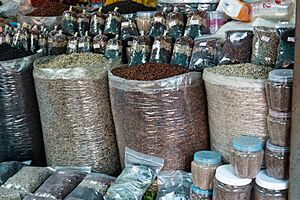
The most common herbs and spices in Cambodian food are sweet basil (ជីរនាងវង, chi néangvông), coriander (Khmer: ជីរវ៉ាន់ស៊ុយ, chivănsŭy), hot mint (Khmer: ជីរពងទាកូន, chi pông téa kon), turmeric (រមៀត, rômiĕt), garlic, ginger (ខ្ញី, khnhei), galangal (រំដេង, romdeng), kaffir lime leaves (ស្លឹកក្រូចសើច, slœ̆k kroch saeuch), lemongrass (ស្លឹកគ្រៃ, slœ̆k krey), and scallions.
Some regions in Cambodia are famous for their spices. Kampot pepper and Kampong Speu palm sugar (Khmer: ស្ករត្នោតកំពង់ស្ពឺ, Skor Thnaot Kompong Speu) are so special they have protected names, like famous wines. The Cardamom Mountains are known for wild cardamon plants, and Battambang Province is famous for its turmeric. Growing peppercorns in Cambodia dates back to at least the 13th century. Kampot pepper is often called the world's best because of its unique strong, yet delicate smell and slightly sweet, eucalyptus taste.
Kroeung
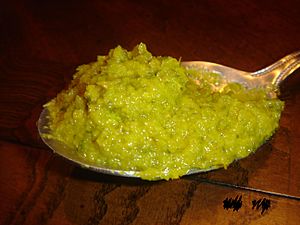
Kroeung (Khmer: គ្រឿង, krœăng – meaning 'ingredients') is a fresh flavoring paste that is a key part of Cambodian cooking. It's used in curries, soups, and stir-fries. The basic paste is made by pounding lemongrass, galangal, garlic, shallots, kaffir lime leaves, and turmeric. There are five main types of kroeung, each with different uses and colors, like yellow, green, and red.
Vegetables
Cambodian meals use a lot of leaf vegetables, such as water morning glory (Khmer: ត្រកួន, trâkuŏn), cabbage (Khmer: ស្ពៃក្តោប, spey kdaôp), Chinese kale (Khmer: ខាត់ណាចិន, khăt-na chĕn), and waterccress (Khmer: ច្រាច់, crac). These are used in soups, stir-fries (ឆា, chá), and salads.
Cambodian cuisine also uses different squashes, like bitter melon (ម្រះ, mreăh) and winter melon (Khmer: ផ្លែត្រឡាច, phlê trâlach). Many root vegetables are also used, such as carrots (ការ៉ុត, karŏt), cassava (Khmer: ក្ដួច, kduŏch), potatoes (ដំឡូង, dámlong), and sweet potatoes (Khmer: ដំឡូងជ្វា, dámlong chvéa). Other vegetables include cucumbers (ត្រសក់, trâsák), eggplants (ត្រប់, tráp), and tomatoes (ប៉េងប៉ោះ, péngpaôh). Many unripe fruits, like papaya, green banana, and mango, are also used as vegetables.
Fruits

Fruits are so popular in Cambodia that they have their own "royal court." The durian (ទុរេន, tŭrén) is the "king," the mangosteen the "queen," sapodilla (Khmer: សាប៉ូឌីឡា) the "prince," and the milk fruit (Khmer: ផ្លែទឹកដោះគោ, phlê tœ̆k daôh ko) the "princess." Other popular fruits include pineapple (ម្នាស់, mnoăh), papaya (ល្ហុង, lhŏng), watermelon (ឪឡឹក, âulœ̆k), banana (ចេក, chék), mango (ស្វាយ, svay), and rambutan (សាវម៉ាវ, sav mav).
Even though fruits are usually desserts, some, like ripe mangoes, watermelon, and pineapples, are often eaten with very salty fish and plain rice. Fruits are also made into smoothies (ទឹកក្រឡុក, tœ̆k krâlŏk). Popular fruits for smoothies are durian, mangoes, and bananas. Sun-dried limes boiled in sugar and salt water are used in chicken and duck soups, sauces with fish, and drinks.
Since 2018, Koh Trong pomelos (Khmer: ក្រូចថ្លុងកោះទ្រង, kroch thlŏng Kaôh Trông) are recognized as a special product from Cambodia. Pomelos grown in the Kratié Province's Koh Trong commune are known for being sweeter and having no seeds when ripe.
Fish and Meat
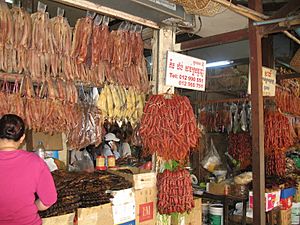
There are over 900 different types of freshwater and saltwater fish in Cambodia. About 475,000 tons of fish (ត្រី, trei) are caught each year. On average, a Cambodian person eats 63 kg of fish annually! Fish are fried, dried, smoked, and fermented into prahok and fish sauce. Fish and fish products are eaten two to three times a day. Popular fish include snakeheads, snappers, catfishes, and mackerels. One Cambodian chef, Luu Meng, thinks that about 40–50% of Cambodian dishes are made with fish.
In the late 13th century Khmer Empire, cows were not used for riding, meat, or hides. Geese had just been brought in by Chinese sailors. Since the 1980s, eating meat has become much more common in Cambodia, especially in the capital city. Today, eating beef (Khmer: សាច់គោ, săch koo), pork (Khmer: សាច់ជ្រូក, săch chruk), and poultry is normal. In Siem Reap, ground pork or beef is made into spicy or sweet and savory sausages (Khmer: សាច់ក្រក, săch krɑɑk) that are eaten with steamed white rice, rice porridge, or baguettes. Beef and chicken (Khmer: សាច់មាន់, săch mŏən) are stewed, grilled, or stir-fried. Duck meat (Khmer: សាច់ទា, săch tiə), roasted in a char siu style, is popular during festivals.
Other seafood includes many types of shellfish like crabs (ក្ដាម, kdaam), clams, cockles (ងាវ, ngiəw), crayfish (បង្កង, bang kang), shrimp, and squid (ត្រីមឹក, trei mik). Boiled or fried cockles seasoned with salt, chili, and garlic are a popular street food. Giant freshwater prawns are usually only eaten by middle and upper-class Cambodians because they are expensive. More unusual meats include frogs (កង្កែប, kɑngkaep), turtles (អណ្ដើក, ɑndaək), and arthropods like tarantulas (Khmer: សត្វអាពីង, sata ping), grasshoppers (កណ្ដូប, kandoup), and crickets (ចង្រិត, cɑngrət). Crickets, water bugs, and tarantulas are seasoned, deep-fried, and sold as street food.
Noodles
Cambodian noodles are made from rice, wheat, and tapioca flour (banh kanh (Khmer: បាញ់កាញ់, bañ kañ)). They come in different thicknesses. Wheat noodles, like hand-pulled noodles (Khmer: មី, mii) and thin wheat vermicelli (Khmer: មីសួ, mii suə), came from Chinese cooking but are now used in unique Cambodian noodle soups and stir-fries. Rice noodles include the local, lightly fermented num banhchok (Khmer: នំបញ្ចុក), as well as rice vermicelli (Khmer: គុយទាវ, kŭytéav).
Popular Cambodian Dishes
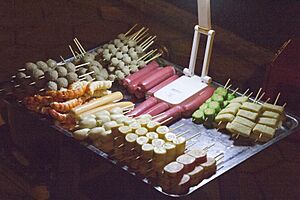
In Cambodia, street food (ម្ហូបតាមផ្លូវ) is seen more as a snack than a full meal. Food stalls are called hang bai (ហាងបាយ) or simply hang (Khmer: ហាង), which is a word borrowed from Chinese meaning "store" or "business." Stalls are often named after the main food they serve, like rice noodle stalls (Khmer: ហាងគុយទាវ, hang kŭytéav).
Noodle Soups

Soups, Stews, and Curries
Samlar (Khmer: សម្ល) refers to soup dishes that are eaten with rice. The borrowed word sup (Khmer: ស៊ុប) refers to dishes that can be eaten without rice, usually those of Chinese or French origin.
Stir-fries and Rice Dishes
The Khmer word cha (Khmer: ឆា) means the stir-frying cooking method, which came from the Chinese.
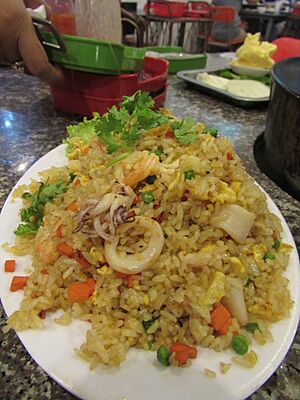

Salads, Rolls, and Steamed Foods
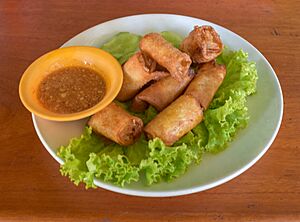
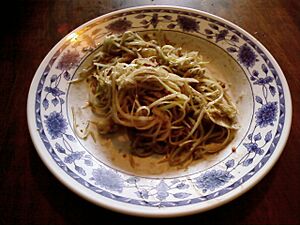
There are two types of salads: gnoam with cooked meat, and p'lear where the meat is either raw or "cooked" in a citrus dressing.
Pastries

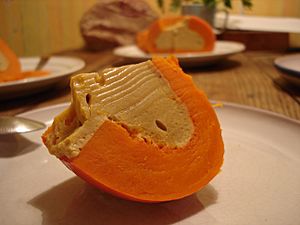
Most Cambodian pastries use either rice or tapioca flour. Chinese and French-influenced pastries, like num pao, might also use wheat flour.
- Saku (tapioca dessert): A steamed dessert made from chestnut flour, coconut milk, and cooked mung beans.
- Sesame balls (Khmer: នំក្រូច, num kroch – 'orange cake'): A fried pastry with a mung bean filling, brought to Cambodia by Chinese immigrants. It's called "orange cake" because it looks like an orange.
Sticky Rice Dishes and Dumplings
- Bai ben (Khmer: បាយបិណ្ឌ): A sticky rice dessert shaped into a ball and topped with sesame seeds. It's very popular during Pchum Ben (a Cambodian festival).
- Durian sticky rice (Khmer: បាយដំណើបទុរេន, bai damnaeb tŭrén): A sticky rice dessert with sweet coconut milk and slices of durian fruit. A similar dish is mango sticky rice (Khmer: បាយដំនើបស្វាយ, bai damnaeb svay).
- Siev mai (Khmer: ស៊ីវម៉ៃ): A Cambodian version of Chinese pork dumplings. In Khmer, "siev mai" also refers to a type of meatballs created by Chinese immigrants in Phnom Penh.
- Steamed sticky rice cakes: Sticky rice flour pastries steamed in banana leaves with sweet or savory fillings. The pyramid-shaped num chang are filled with pork, sausage, and beans, similar to Chinese zongzi. The cylinder-shaped num ansom (Khmer: នំអន្សម) can be filled with sugar bananas (Khmer: នំអន្សមចេក, num ansom chek), jackfruits, or pork (Khmer: នំអន្សមជ្រូក, num ansom chrouk). Besides steaming, num ansom can also be fried or grilled. The cylinder shape represents Shiva, a masculine god, while the pyramid shape represents Shakti, a feminine god. Sticky rice cakes are offered to ancestors during Pchum Ben to ask for blessings for the rice fields.
- Tapioca pearl balls (Khmer: នំសាគូ, num saku): Tapioca balls with a meat filling. Minced meat is seasoned, cooked, wrapped in tapioca, and steamed. It's often served with vegetables and sweet sauce.
Puddings, Sweet Porridges, and Jellies
Cambodian desserts include puddings (Khmer: ចាហួយទឹក, cha houy teuk), sweet porridges (Khmer: បបរផ្អែម, babor p'aem), and agar jellies (Khmer: សារាយ, sarai).
- Grass jelly (Khmer: ចាហ៊ួយខ្មៅ, cha huoy khmaw): Often eaten with soybean milk on hot days because it's believed to be cooling.
- Num lot: A green or white dessert made from rice flour in a liquid of coconut milk, water, and sugar.
Drinks in Cambodia
Water is the most popular drink. In rural areas, people often boil water at home and drink it hot because clean drinking water isn't always easy to find. In cities, you can buy bottled water, sodas, and sweet fruit drinks. Green tea (តែបៃតង, tê baitâng) is drunk all day. It's thought that the Chinese brought it to the Khmer Empire. Even though more people drink it now, most green tea is imported, and very little is grown in Cambodia. There are efforts to grow more Cambodian tea. Lemon iced tea (Khmer: តែទឹកក្រូចឆ្មា, tae krouc chmaa) is also popular.
In cities, coffee (Khmer: កាហ្វេ, kaafee) is also popular. It's usually served with sweetened condensed milk instead of black. Coffee can be served iced ({{Wiktionary:កាហ្វេទឹកកក|កាហ្វេទឹកកក}}, kaafee tœ̆k kɑɑk) or hot. You can buy it from coffee carts, coffee shop chains, and special coffee shops. Most coffee in Cambodia comes from other countries like Vietnam, Laos, and Thailand.
Smoothies (Khmer: ទឹកក្រឡុក, tœ̆k krɑlok) are a big part of evening drinks. You can find them at juice stalls in towns everywhere from late afternoon. They can have a mix of fruits or just one or two. Coconut milk, sugar syrup, condensed milk, and shaved ice are added, and sometimes a raw egg (unless you ask for no egg). Soy milk (Khmer: ទឹកសណ្ដែក, tœ̆k sɑndaek) is sold in the morning by street vendors. The green version is sweet and thicker than the unsweetened white one. It can be served hot or cold, sweet or unsweetened. Sugarcane juice (ទឹកអំពៅ, tœ̆k ʼɑmpɨw) is another popular street drink. It's made by pressing juice from sugarcane stalks with a special machine. It's served with ice and sometimes flavored with citrus to balance the sweetness. Pandan juice (Khmer: ទឹកតើយ, tœ̆k taeuy) is made from pandan leaves and often sold at Cambodian food stalls.
Fermented Drinks
A Chinese diplomat named Zhou Daguan wrote that in the late 13th century Khmer Empire, five types of fermented alcoholic drinks were made. These included mead (a honey wine), and wines made from rice, sugar, and palm starch.
Today, the most popular alcoholic drink is beer (ប៊ីយេរ, biiyɛɛ). The first beer made in Cambodia was in the 1930s during the French Indochina period. In 1995, people drank only about two liters of beer per person each year. But by 2004, this started to grow a lot, and in 2010, beer became more popular than spirits. Now, there are four big beer makers in Cambodia. Recently, many small craft breweries have also opened.
A popular traditional alcoholic drink is rice wine (ស្រាស, sra sa). It's made by fermenting boiled and dried rice with a natural starter for at least 24 hours, then distilling it. Sometimes, people get sick from bad homemade rice wine. Rice wine can also be mixed with herbs, roots, bark, and insects to make medicinal wines.
Another popular, but less fancy, alcoholic drink is palm wine (ទឹកត្នោតជូរ, tœ̆k tnaot cuu). It might have become popular during the French Indochina period as a cheaper option. Palm wine is made by fermenting the sap from Asian palmyra palm trees.
In Mondulkiri Province, yellow and purple passion fruit wine is a local drink. Samai Distillery, Cambodia's first rum distillery, makes rum and even uses Kampot peppercorns in one of its products. Cambodia's first and only winery, Chan Thai Choeung in Battambang, has been making grape wine since 2005.
Meals and Eating Customs
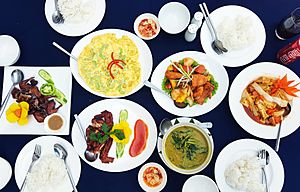
In Cambodia, meals are usually made fresh three times a day for breakfast, lunch, and dinner. However, in rural areas, people might only eat breakfast and dinner. Because there isn't much refrigeration, leftovers are usually thrown away. A typical Cambodian breakfast includes rice porridge with dried salted fish, or rice/egg noodles with meat and vegetables. For lunch and dinner, Cambodians usually eat steamed rice, soup with meat (fish, pork, chicken, or beef) and vegetables, fried fish or other meat, and fruit.
In Cambodian meals, just like in the rest of Southeast Asia, all dishes are served and eaten at the same time. This is different from European meals, where dishes are served one after another, or Chinese meals, where courses overlap. Several side dishes are usually served with the main dishes. Also, many condiments are available, like chili jam, pickled green chilies, sugar, garlic flakes, fish sauce, and soy sauce. While rice and soups are usually hot, side dishes can be served at room temperature. People balance the flavors and enjoy their meal by combining different dishes with rice. For example, a Cambodian meal might have a sour soup, a salty fish, fried vegetables, and plain rice. This is different from Thai food, where sourness, saltiness, sweetness, and spiciness are often all in one dish.
Khmer food was traditionally eaten with hands. But today, spoons, forks, and chopsticks are also used. Knives are rarely used because most Cambodian food is already cut into bite-sized pieces. Forks and spoons were brought by the French and are used for eating rice and soup dishes. Chopsticks were brought by the Chinese and are only used for noodle dishes.
Cambodian Food Around the World
Cambodian cuisine is not very well known around the world. Websites like Far & Wide and Food Republic have called Cambodian cuisine one of the most "underappreciated" or "underrated" cuisines in Asia. Fodor's Travel called it "the most underrated in Southeast Asia."
Outside of Cambodia, you can usually find Cambodian food in countries with many Cambodian immigrants, like the United States, France, Australia, and Canada. These restaurants often serve the local Cambodian community. However, because of business reasons and the mix of people in the Cambodian community, many Cambodian-owned restaurants choose to serve more well-known Thai, Chinese, and Vietnamese food instead.
Food Diplomacy: Sharing Cambodian Cuisine
In December 2020, Cambodia's Ministry of Foreign Affairs started a "Food Diplomacy 2021–2023" plan. This was part of a bigger plan to help Cambodia's economy. At the launch, the Foreign Minister, Prak Sokhonn, listed prahok, fish amok, pomelo salad, samlar kako, and num banhchok as some of the Khmer dishes to be promoted. The ministry also started programs to train Cambodian cooks for embassies and to teach ambassador's spouses about Khmer cuisine.
In February 2021, the ministry published a cookbook called "The Taste of Angkor" to help promote Cambodian food in other countries. A 1960 Cambodian cookbook, "The Culinary Art of Cambodia," was also re-published and included in the campaign. In June 2021, a series of videos called "Taste Cambodia" were released. They showed Khmer foods and cooking activities in different parts of Cambodia. In May 2022, new cooking training centers called "Angkor Kitchen" were opened at the Ministry of Foreign Affairs.
Awards for Cambodian Cuisine
Cookbooks
The cookbook "From Spiders to Water Lilies, Creative Cambodian Cooking with Friends" won the 2009 Gourmand World Cookbook Award for "Best Asian Cuisine Cookbook." It was the first book from Cambodia to win this award.
A French-language Khmer cookbook, Au Pays de la Pomme Cythère, de Mère en Fille, Authentiques Recettes Khmères, won the 2010 Gourmand Awards as the world's "Best Asian Cuisine Cookbook." The English version, "Ambarella, Cambodian Cuisine," won the same award in 2014.
"The Taste of Angkor" cookbook, published by Cambodia's Ministry of Foreign Affairs, won the 2021 Gourmand World Cookbook Award as the "Best Asian Cookbook." It also won awards in 2022 for "Best Asian Cuisine Book" and "Heads of State/Food" for its introduction written by Deputy Prime Minister Prak Sokhon.
The re-published Cambodian cookbook, "The Culinary Art of Cambodia," received a "Special Award of the Jury" at the 2022 Gourmand World Cookbook Awards.
Restaurants
Joannès Rivière's Cuisine Wat Damnak restaurant was listed as No. 50 in Asia's 50 Best Restaurants in 2015. It was the first Cambodian restaurant to make this list. In 2016, it moved up to 43rd place. In 2020, the Embassy restaurant, led by the Kimsan Twins, was included in Asia's 50 Best Restaurants' new "50 Best Discovery" list.
Chefs
Cambodian chef Luu Meng received the "Asia's Top Chef" award from magazines in Malaysia and Asia in 2014.
Cambodian chefs from the Cambodia Chefs' Association won the 2019 ASEAN Gourmet Challenge with three gold medals. They also won six silver and 17 bronze medals in other categories at the Thailand Ultimate Chef Challenge in Bangkok.
See also
 In Spanish: Gastronomía de Camboya para niños
In Spanish: Gastronomía de Camboya para niños


